Zotac GeForce GT 640 DDR3 Review: Glacial Gaming & Heavenly HTPC
by Ryan Smith & Ganesh T S on June 20, 2012 12:00 PM ESTPortal 2, Battlefield 3, Starcraft II, Skyrim, & Civ V
Portal 2 continues to be the latest and greatest Source engine game to come out of Valve's offices. While Source continues to be a DX9 engine, and hence is designed to allow games to be playable on a wide range of hardware, Valve has continued to upgrade it over the years to improve its quality, and combined with their choice of style you’d have a hard time telling it’s over 7 years old at this point. From a rendering standpoint Portal 2 isn't particularly geometry heavy, but it does make plenty of use of shaders.
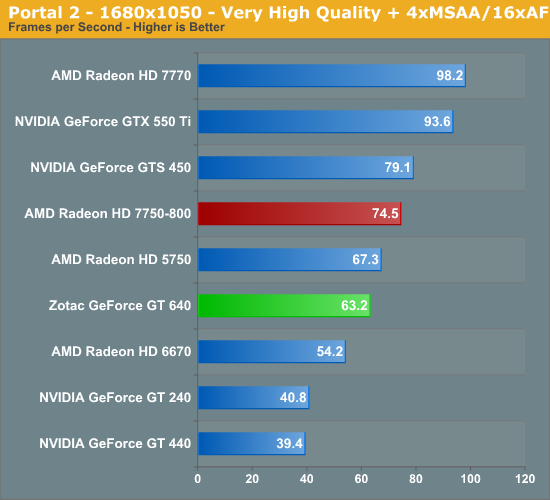
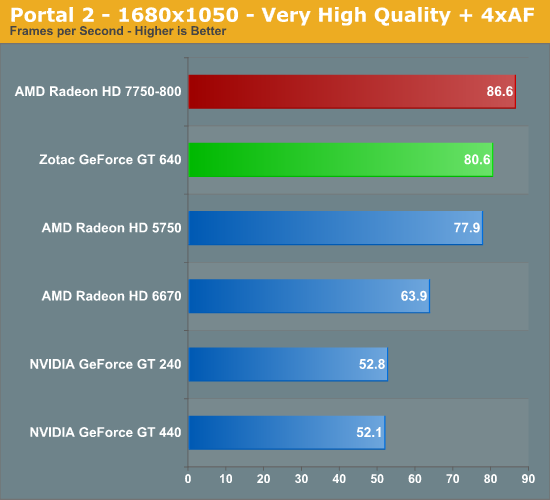
Portal 2 ends up being one of the better games for the GT 640, both on an overall basis and on a competitive basis. Overall we’re able to run Portal 2 at 1680 with maximum quality and with MSAA, and still hit 60fps, marking the first time we’ve been able to use such high settings on this card. At the same time the GT 640 is about as close to the 7750 as it’s ever going to get; it still trails by over 15% but this is a far better showing than earlier with games like DiRT 3. Performance relative to the GT 440 also once again looks good, with the GT 640 improving on the GT 440 by 60%.
Battlefield 3
Its popularity aside, Battlefield 3 may be the most interesting game in our benchmark suite for a single reason: it was the first AAA DX10+ game. Consequently it makes no attempt to shy away from pushing the graphics envelope, and pushing GPUs to their limits at the same time. Even at low settings Battlefield 3 is a handful, making it difficult to run on low-end GPUs.
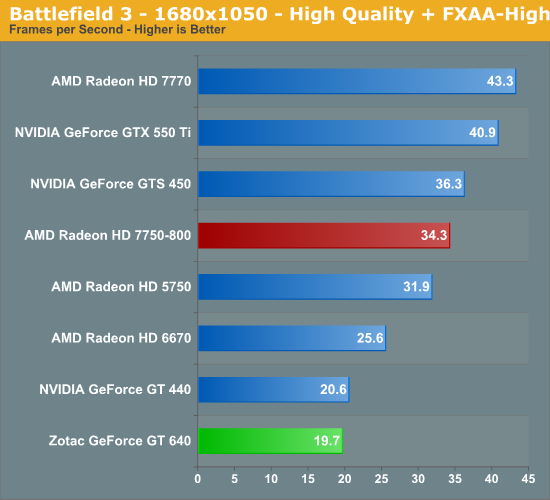
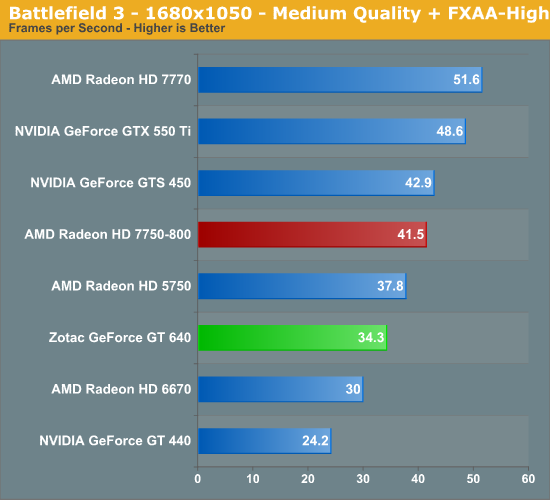
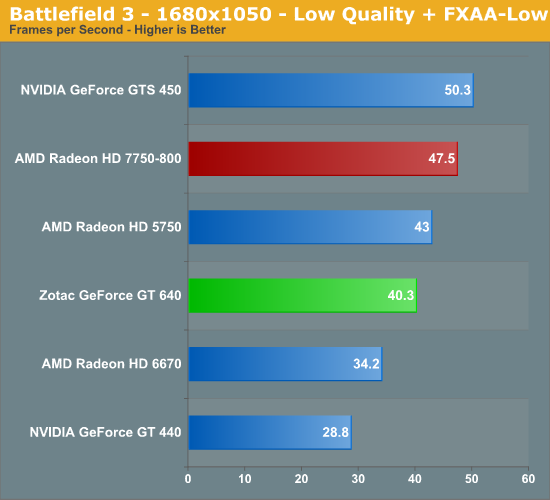

We ultimately had to iterate through several different settings to find something the GT 640 could handle with BF3. 1680 is right out – even at minimum quality it could only hit 40fps in our test, which in a severe firefight means that framerates will bottom out at around 20fps. Only by finally backing off on the resolution to 1366x768 were we able to hit 60fps. So it’s definitely playable, but 1680 just isn’t going to happen.
Of course it goes without saying that the GT 640 once again gets left in the dust here by its competition. At High quality (our common benchmark for all single-GPU cards) it can’t even surpass the GT 440 due to the lack of memory bandwidth, and at lower settings the 7750 is still 20% ahead. At best you can point to our iGPU results and see that the GT 640 triples the HD 2500’s performance, reflecting the fact that even a slow dGPU is still faster than a slow iGPU.
Starcraft II
Our next game is Starcraft II, Blizzard’s 2010 RTS megahit. Starcraft II is a DX9 game that is designed to run on a wide range of hardware, and given the growth in GPU performance over the years it's often CPU limited before it's GPU limited on higher-end cards.
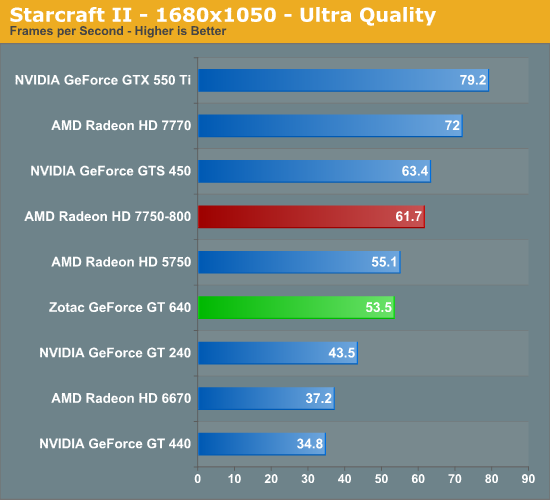
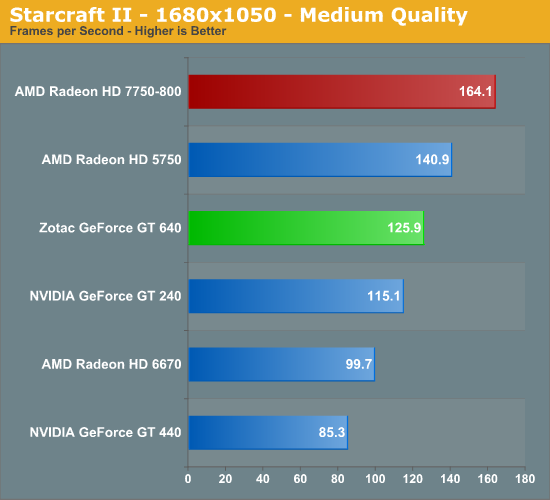
Starcraft II is another game that NVIDIA tends to do well in, and while it’s still not enough to make the GT 640 competitive with the likes of the 7750 or GTS 450, it’s enough to reduce the gap. The 7750 leads by only 15% here, the smallest lead of the day. Meanwhile the GT 640 improves on the GT 440 by 53% here, once again showcasing the impact of such a large increase in ROPs, shaders, and texture units.
Skyrim
Bethesda's epic sword and magic game The Elder Scrolls V: Skyrim is our RPG of choice for benchmarking. It's altogether a good CPU benchmark thanks to its complex scripting and AI, but it also can end up pushing a large number of fairly complex models and effects at once. This is a DX9 game so it isn't utilizing any advanced DX11 functionality, but it can still be a demanding game.
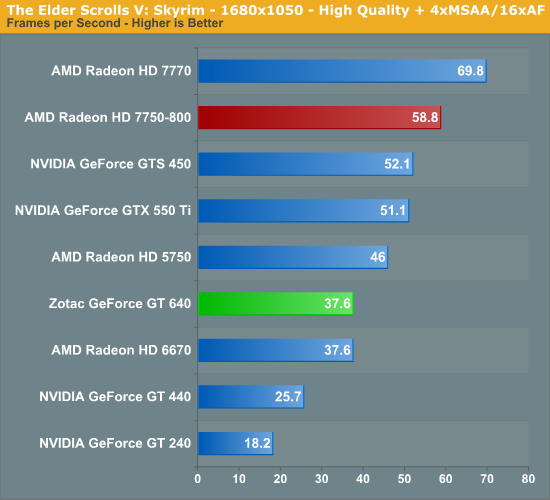
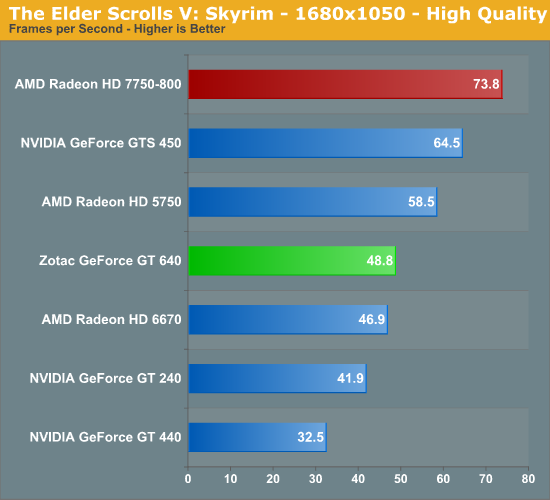
If we iterated through enough settings I’m sure we’d find something that the GT 640 could hit 60fps on, but thankfully it’s generally playable above 30fps, so 1680 at High quality should be fine for most users. Here it narrowly beats the 6670, but the 7750 and GTS 450 are well ahead, once again reflecting the relatively poor gaming performance of the GT 640.
Civilization V
Our final game, Civilization 5, gives us an interesting look at things that other RTSes cannot match, with a much weaker focus on shading in the game world, and a much greater focus on creating the geometry needed to bring such a world to life. In doing so it uses a slew of DirectX 11 technologies, including tessellation for said geometry, driver command lists for reducing CPU overhead, and compute shaders for on-the-fly texture decompression. And the release of a new expansion pack today should keep Civ V relevant to gamers for some time to come.
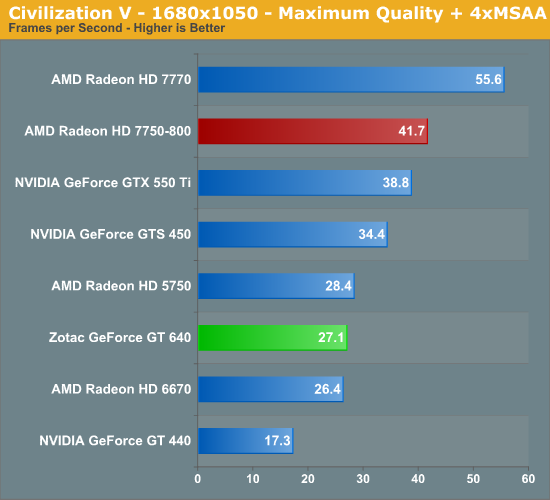
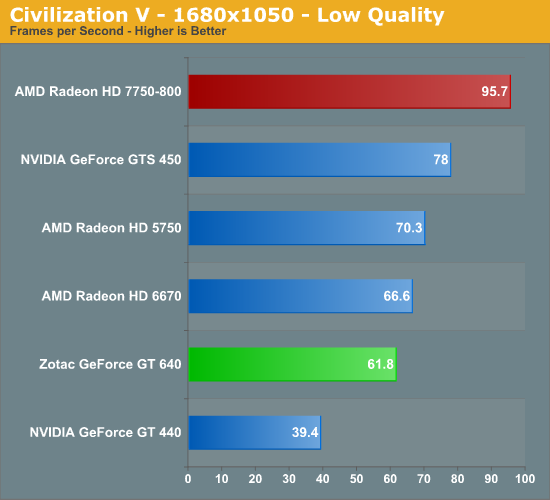
With Civilization V the GT 640 starts roughly the same as it started: poorly. The 7750 leads by over 50% at our highest settings, a gap wide enough to make the 7750 more than playable at these settings while the GT 640 struggles. The 56% improvement from the GT 440 means that NVIDIA is still making solid gains compared to the GT 440, but it’s just not enough.










60 Comments
View All Comments
HighTech4US - Wednesday, June 20, 2012 - link
At least hen the GT240 was released it came in both DDR3 and GDDR5.UNhooked - Wednesday, June 20, 2012 - link
I wish there was some sort of Video encoding benchmark. I have been told AMD/ATI cards aren't very good when it comes to video encoding.mosu - Thursday, June 21, 2012 - link
who told you that kind of crap ?Please check the internet.Rumpelstiltstein - Thursday, June 21, 2012 - link
Did this low-end offering really manage to pull off these kind of numbers? I'm impressed. Not something I would buy personally, but I would have no problems recommending this to someone else.Samus - Thursday, June 21, 2012 - link
DDR3....ruined a perfectly good chip.Deanjo - Thursday, June 21, 2012 - link
Noooooo! Come on, post some benchmarks as it is right now. Some of us do not want to wait for AMD to get their VCE in order. People have been waiting for VCE for months and there is no valid reason to hold off NVENC waiting for their competitor to catch up. When and if VCE support comes out then run a comparison then.
ganeshts - Thursday, June 21, 2012 - link
NVIDIA indicated that official NVENC support in CyberLink / ArcSoft transcoding applications would come in July only. Till then, it is beta, and has scope for bugs.Deanjo - Thursday, June 21, 2012 - link
So? That didn't prevent them benching trinity and it's encoding capabilities despite it all being beta there.http://www.anandtech.com/show/5835/testing-opencl-...
drizzo4shizzo - Thursday, June 21, 2012 - link
So... do these new cards still support HDTV 1080i analog signals for those of us who refuse to give up our 150lb 34" HDTV CRTs?ie. ship with a breakout dongle cable that plugs into the DVI-I port? If they don't ship with one can anyone tell me if they are compatible with a 3rd party solution? For it to work the card has to convert to the YUV colorspace. My old 7600gt *did* support this feature, but none of the new cards mention it...
Upgrading my TV also means buying a new receiver for HDMI switching to the projector, fishing cable in walls, and all manner of other unacceptable tradeoffs. Plus monay.
Thanks!
philipma1957 - Thursday, June 21, 2012 - link
I have a sapphire hd7750 ultimate passive cooled card.This card seems to be worse in every case except it is 1 slot not 2.
The passive hd7750 is 125 usd this is 110 usd.
I am not sure that I would want this until they make a passive version.